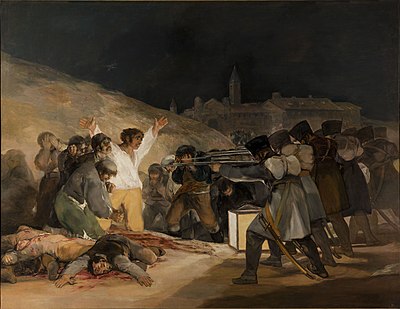
Back الثالث من مايو (لوحة) Arabic ايل تريس دى مايو ARZ El 3 de mayu en Madrid AST 3 may 1808 AZ Трэцяга мая 1808 года ў Мадрыдзе BE Трети май 1808 година в Мадрид Bulgarian Tres de Mayo BR El tres de maig a Madrid Catalan Popravy 3. května 1808 Czech Den tredje maj 1808 Danish
| The Third of May 1808 | |
|---|---|
 | |
| Artist | Francisco Goya |
| Year | 1814 |
| Medium | Oil on canvas |
| Dimensions | 268 cm × 347 cm (106 in × 137 in)[1] |
| Location | Museo del Prado, Madrid |
The Third of May 1808 in Madrid (also known as El tres de mayo de 1808 en Madrid or Los fusilamientos de la montaña del Príncipe Pío,[2] or Los fusilamientos del tres de mayo. Commonly known as The Third of May 1808.)[1] is a painting completed in 1814 by the Spanish painter Francisco Goya, now in the Museo del Prado, Madrid. In the work, Goya sought to commemorate Spanish resistance to Napoleon's armies during the occupation of 1808 in the Peninsular War. Along with its companion piece of the same size, The Second of May 1808 (or The Charge of the Mamelukes), it was commissioned by the provisional government of Spain at Goya's own suggestion shortly after the ousting of the French occupation and the restoration of King Ferdinand VII.
The painting's content, presentation, and emotional force secure its status as a ground-breaking, archetypal image of the horrors of war. Although it draws on many sources from both high and popular art, The Third of May marks a clear break from convention. Diverging from the traditions of Christian art and traditional depictions of war, it has no distinct precedent, and is acknowledged as one of the first paintings of the modern era.[3] According to the art historian Kenneth Clark, The Third of May 1808 is "the first great picture which can be called revolutionary in every sense of the word, in style, in subject, and in intention".[4]
The Third of May 1808 inspired Gerald Holtom's peace sign and a number of later major paintings, including a series by Édouard Manet, and Pablo Picasso's Massacre in Korea and Guernica.
- ^ a b The Museo del Prado entitles the work El 3 de mayo de 1808 en Madrid: los fusilamientos en la montaña del Príncipe Pío Archived October 15, 2012, at the Wayback Machine
- ^ Prado, p. 141. "The third of May 1808 in Madrid; the shootings on the Prince Pio Hill". See Príncipe Pío for the location.
- ^ Licht, pp. 116–127.
- ^ Clark, p. 130.